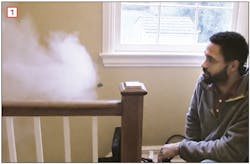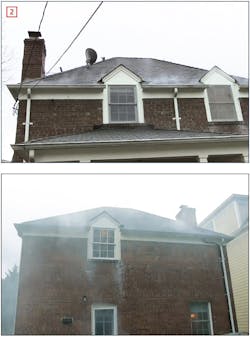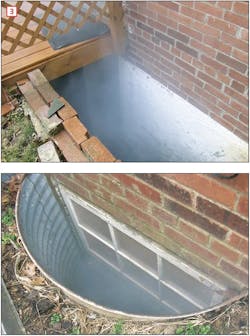How to Smoke Out Air Leaks
[1] A fog machine uses glycerin to create a thick but harmless fog that can fill the average house in just a few minutes. When a blower door fan is reversed, putting the house under positive pressure, the fog is forcibly pushed out through openings in the building’s envelope.
Mark IV Builders likes to measure the results of its remodeling work. One tool the company uses is a blower door to test the air tightness of the house before they begin remodeling, and then again after their work is complete. The results demonstrate to clients and field employees how much attention to detail can pay off.
Lately, the company has experimented with adding a new element to some of its test-in and test-out processes. Instead of relying solely on manometer readings to reveal air leaks, they use a theatrical smoke machine to fill the house with “smoke.” The smoke is actually a harmless glycerin fog that doesn’t do any damage and dissipates readily, but while the blower door is running, the fog makes it easy to see where the air leaks are. Results are so dramatic, the company made a video featuring Ray Williams, a Mark IV superintendent. Here are the highlights.
Where There’s Smoke
Before starting the test, Williams follows a checklist to ensure not only that the results are accurate, but that the test doesn’t create any gas leaks or fire hazards (see “Blower Door Pre-Test Checklist,” opposite). After checking off the list and setting up the blower door, Williams starts the fog machine. “Even though we do blower door tests all the time,” Williams says, “to help our field employees understand the natural paths where air leakage occurs, we are going to fill the house with theatrical smoke.”
[2] A lot of fog leaked out at dormers and eaves (top and above) on all sides of the building because the framing connections were not sealed where the rafters crossed the exterior wall plates.
As the fog spreads throughout the house, all that’s left is to turn on the blower door, but not before Williams reverses the fan. A standard blower door test pulls air out of the house and measures how fast it is replenished through leaks in the envelope. But for the fog test, Williams says, “we want to put the house under a little bit of positive air pressure.” The increase in pressure forcibly pushes the fog out through any openings in the envelope, making the leaks easier to see from outside.
The fog test dramatically demonstrates where and how severe the air leaks are. In this case, fog was clearly visible leaking from the eaves, around doors and windows (especially in the basement), and at the perimeter where the rim joist meets the foundation, as shown in the series of photos above.
Blower Door Pre-Test Checklist
You can buy an 18,000 cfm fog machine online for less than $150, or you can rent one, as Mark IV Builders did, from a music store (they rent it to bands). According to Mark Scott, founder and president of Mark IV Builders, using a fog machine is “not something I could do all the time, but it is a very graphic display of air leaking.” Results can vary. On this project, for example, old windows didn’t show much leakage, but poor weatherstripping around the basement door was obvious. But the results were spectacular enough to have had a lasting effect on observers. “Everyone was surprised at the volume of fog that came out at the eaves,” says Scott. “I think that got everyone to step up their vigilance for better air sealing.”
The air sealing has a lasting effect, too. At one recent project that doubled the square footage of the house, Mark IV Builders’ air sealing efforts cut blower door air leakage measurements by more than 60%
[3] Clouds of fog leaked from a poorly weatherstripped basement door (top) and window (above). Rim joists are also a source of basement air leaks when plates and sills are not carefully sealed.
Thanks to Mark Scott and Ray Williams of Mark IV Builders, a custom building and remodeling company in Cabin John, Md., for sharing their leak test proceduce, and to Dan Morrison, editor-in-chief of ProTradeCraft.com, who produced the video.




